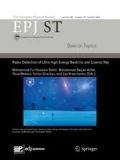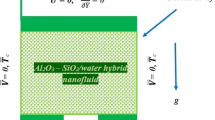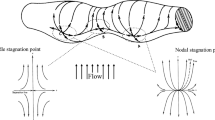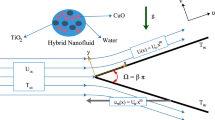Abstract
The fascinating properties of hybrid nanofluid consisting of chemical and mechanical strength, excellent thermal and electrical conductivity, lower cost, high heat transfer rates, and physico-chemical reliability make it a desirable fluid in thermal energy system. Bearing in mind such exhilarating features of hybrid nanofluid, our intention in current research is to examine the heat and flow transfer rates in water-based hybrid nanofluid with suspension of hybrid nanoparticles (Cu–\(\hbox {Fe}_{3}\hbox {O}_{4}\)) past a vertical cone enclosed in a porous medium. The effects of external magnetic field, thermal radiation, and non-uniform heat source/sink are additional features to the innovation of the constructed mathematical model. The set of nonlinear coupled equations supported by related initial and boundary conditions is executed numerically using finite difference method. In the analysis of coupled distribution, the impact of various controlling parameters on velocity and temperature are scrutinized and the obtained results are exhibited graphically. The physically important quantities such as heat transfer coefficient and wall shear stress are evaluated versus governing constraints. In addition, the heat transfer performance of (Cu–\(\hbox {Fe}_{3}\hbox {O}_{4}\))–water hybrid nanofluid is compared with \({\hbox {Fe}_{3}\hbox {O}_{4}}\)–water and Cu–water, and their results are summarized in the tables. For both types of nanofluids, solo and hybrid, it is witnessed that the temperature of the system increases in the presence of magnetic field and thermal radiation. Moreover, the velocity of the fluid increases due to high permeability effects. It is also observed that the Nusselt number increases by increasing nanoparticles concentrations in the fluid; however, it decreases in presence of internal heat source. A striking highlight of the executed model is the validation of the findings by comparing them with a content already reported in the literature. In this respect, a venerable coexistence is achieved.


























Similar content being viewed by others
References
S.U. Choi, J.A. Eastman, Enhancing thermal conductivity of fluids with nanoparticles, Technical Report (Argonne National Lab, IL (United States), 1995)
H. Duan, Y. Zheng, C. Xu, Y. Shang, F. Ding, Experimental investigation on the plasmonic blended nanofluid for efficient solar absorption. Appl. Therm. Eng. 161, 114192 (2019)
M.A. Sharafeldin, G. Gróf, O. Mahian, Experimental study on the performance of a flat-plate collector using \(WO_{3}\)/water nanofluids. Energy 141, 2436–2444 (2017)
M.A. Nazari, R. Ghasempour, M.H. Ahmadi, G. Heydarian, M.B. Shafii, Experimental investigation of graphene oxide nanofluid on heat transfer enhancement of pulsating heat pipe. Int. Commun. Heat Mass Transf. 91, 90–94 (2018)
Z. Said, M. Sabiha, R. Saidur, A. Hepbasli, N.A. Rahim, S. Mekhilef, T. Ward, Performance enhancement of a flat plate solar collector using titanium dioxide nanofluid and polyethylene glycol dispersant. J. Clean. Prod. 92, 343–353 (2015)
A. Moghadassi, E. Ghomi, F. Parvizian, A numerical study of water based \(Al_{2}O_{3}\) and \(Al_{2}O_{3}-Cu\) hybrid nanofluid effect on forced convective heat transfer. Int. J. Therm. Scie. 92, 50–57 (2015)
M.H. Esfe, A. Alirezaie, M. Rejvani, An applicable study on the thermal conductivity of swcnt-mgo hybrid nanofluid and price-performance analysis for energy management. Appl. Therm. Eng. 111, 1202–1210 (2017)
B. Sun, Y. Zhang, D. Yang, H. Li, Experimental study on heat transfer characteristics of hybrid nanofluid impinging jets. Appl. Therm. Eng. 151, 556–566 (2019)
M.H. Esfe, S. Esfandeh, S. Saedodin, H. Rostamian, Experimental evaluation, sensitivity analyzation and ann modeling of thermal conductivity of \(ZnO-MWCNT\)/EG-water hybrid nanofluid for engineering applications. Appl. Therm. Eng. 125, 673–685 (2017)
T. Arunkumar, M. Anish, J. Jayaprabakar, N. Beemkumar, Enhancing heat transfer rate in a car radiator by using \(Al_{2}O_{3}\) nanofluid as a coolant. Int. J. Ambient Energy 40, 367–373 (2019)
S. Ghadikolaei, K. Hosseinzadeh, M. Hatami, D. Ganji, MHD boundary layer analysis for micropolar dusty fluid containing hybrid nanoparticles (\(Cu-Al_{2}O_{3}\)) over a porous medium. J. Mol. Liq. 268, 813–823 (2018)
Z. Iqbal, E. Maraj, E. Azhar, Z. Mehmood, A novel development of hybrid (\(MoS_{2}-SiO_{2}/H_{2}O\)) nanofluidic curvilinear transport and consequences for effectiveness of shape factors. J. Taiwan Inst. Chem. Eng. 81, 150–158 (2017)
M. Sheikholeslami, A. Ghasemi, Solidification heat transfer of nanofluid in existence of thermal radiation by means of FEM. Int. J. Heat Mass Transf. 123, 418–431 (2018)
A. Dogonchi, M. Waqas, S. Seyyedi, M. Hashemi-Tilehnoee, D. Ganji, CVFEM analysis for \(Fe_{3}O_4-H_{2}O\) nanofluid in an annulus subject to thermal radiation. Int. J. Heat Mass Transf. 132, 473–483 (2019)
M.W.A. Khan, M.I. Khan, T. Hayat, A. Alsaedi, Entropy generation minimization (EGM) of nanofluid flow by a thin moving needle with nonlinear thermal radiation. Phys. B Condens. Matter 534, 113–119 (2018)
T.A. Alkanhal, M. Sheikholeslami, M. Usman, R.-U. Haq, A. Shafee, A.S. Al-Ahmadi, I. Tlili, Thermal management of MHD nanofluid within the porous medium enclosed in a wavy shaped cavity with square obstacle in the presence of radiation heat source. Int. J. Heat Mass Transf. 139, 87–94 (2019)
M. Alizadeh, A. Dogonchi, D. Ganji, Micropolar nanofluid flow and heat transfer between penetrable walls in the presence of thermal radiation and magnetic field. Case Stud. Therm. Eng. 12, 319–332 (2018)
M.R. Safaei, A. Karimipour, A. Abdollahi, T.K. Nguyen, The investigation of thermal radiation and free convection heat transfer mechanisms of nanofluid inside a shallow cavity by lattice boltzmann method. Phys. A Stat. Mech. Appl. 509, 515–535 (2018)
S. Ghadikolaei, K. Hosseinzadeh, D. Ganji, Investigation on ethylene glycol-water mixture fluid suspend by hybrid nanoparticles (\(TiO_{2}-CuO\)) over rotating cone with considering nanoparticles shape factor. J. Mol. Liq. 272, 226–236 (2018)
H. Hanif, I. Khan, S. Shafie, Heat transfer exaggeration and entropy analysis in magneto-hybrid nanofluid flow over a vertical cone: a numerical study. J. Therm. Anal. Calorim. 141, 2001–2017 (2020)
D. Mythili, R. Sivaraj, Influence of higher order chemical reaction and non-uniform heat source/sink on casson fluid flow over a vertical cone and flat plate. J. Mol. Liq. 216, 466–475 (2016)
J. Crank, P. Nicolson, A practical method for numerical evaluation of solutions of partial differential equations of the heat-conduction type, in Mathematical Proceedings of the Cambridge Philosophical Society, volume 43 (Cambridge University Press), p. 50–67
R. Kannan, B. Pullepu, S.A. Shehzad, Numerical solutions of dissipative natural convective flow from a vertical cone with heat absorption, generation, MHD and radiated surface heat flux. Int. J. Appl. Comput. Math. 5, 24 (2019)
Acknowledgements
The author would like to acknowledge Ministry of Higher Education (MOHE) and Research Management Centre of Universiti Teknologi Malaysia (UTM) for the financial support through vote numbers FRGS/1/2019/STG06/UTM/02/22, 5F004, 5F278, 07G70, 07G72, 07G76, 07G77 and 08G33 for this research.
Author information
Authors and Affiliations
Corresponding authors
Rights and permissions
About this article
Cite this article
Hanif, H., Khan, I. & Shafie, S. A novel study on hybrid model of radiative Cu–\(\hbox {Fe}_3\hbox {O}_4\)/water nanofluid over a cone with PHF/PWT. Eur. Phys. J. Spec. Top. 230, 1257–1271 (2021). https://doi.org/10.1140/epjs/s11734-021-00042-y
Received:
Accepted:
Published:
Issue Date:
DOI: https://doi.org/10.1140/epjs/s11734-021-00042-y




